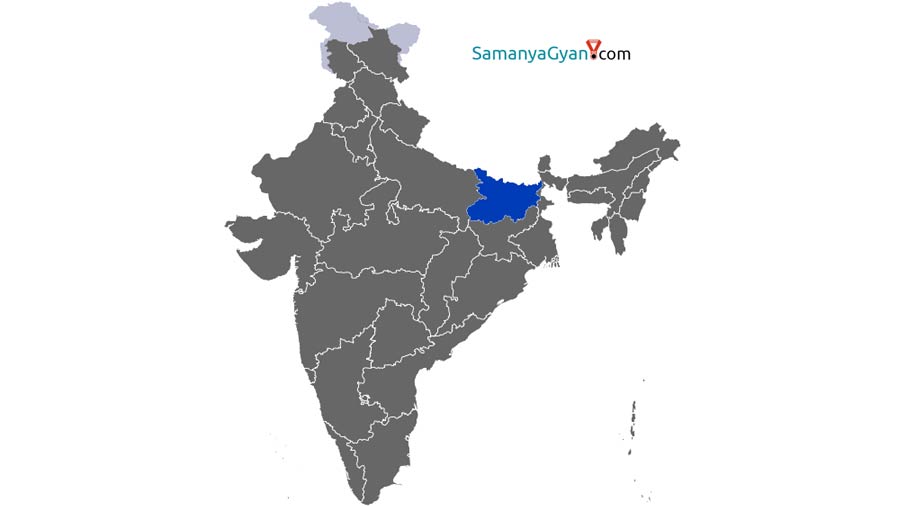Through this chapter, we will know the detailed and important information of Bihar, in which important and interesting information like history, geography, economy, education, culture and world famous tourist places located in the state have been added. Apart from this, the recent developments and changes in the state of Bihar have also been explained in detail. This chapter is full of interesting facts for the competitive aspirants as well as the readers.
Quick General Knowledge
| State Level | State |
| Capital | Patna |
| Statehood | 26 January 1950 |
| Largest City | Patna |
| Total Area | 94,163 km किमी |
| Districts | 38 |
| Current Chief Minister | Nitish Kumar |
| Current Governor | Rajendra Arlekar |
| State Bird | House sparrow |
| State Flower | Bauhinia variegata |
| State Animal | Gaur |
| State Tree | Sacred fig |
| Languages | Hindi |
| State Dance | Jata-Jatin, Bakho-Bakhain, Panwariya, Sama-Chakwa, Bidesia and Jatra . |
Bihar (बिहार)
Bihar is a state located in the eastern part of India. Patna is the capital city of Bihar and the largest city in the state. The ancient name of Patna was Pataliputra. The state is surrounded by Nepal in the northern part, West Bengal in the eastern part and Uttar Pradesh in the western part, Jharkhand in the southern part. Bihar is the 12th largest in the country by area and the third most populous state by population.
Bihar has been a stronghold of vast empires in ancient times. Bihar was earlier known as Magadha. In ancient times the region was ruled by some great dynasties like Bimbisara, Udayan, Chandragupta Maurya, Emperor Ashoka Maurya, Sunga dynasty and Kanva dynasty, followed by Kushan rulers and later Chandragupta Vikramaditya of Gupt dynasty. In the medieval period, the Muslim rulers ruled this area.
In the modern period, Babu Kunwar Singh of Bihar played an important role in the first freedom struggle of 1857. Bengal was partitioned in 1912 and consequently the state of Bihar came into existence. In the year 1936, Orissa was divided from Bihar. After independence, Bihar got another division and in 2000, the state of Jharkhand was separated from it.
The state of Bihar comes under a bicameral system in the federal structure of the Indian Republic. The constitutional head of the state is the Governor but the real power rests with the Chief Minister and the Council of Ministers.
Among the major political parties in Bihar, the NDA which includes the BJP, the Janata Dal, the Indian National Congress and the Rashtriya Janata Dal-led coalition.
The current Chief Minister of Bihar is Nitish Kumar. He has been working as the Chief Minister of the state since 2007. Shrikrishna Singh was the first person to become the Chief Minister of Bihar. He was sworn in as the Chief Minister of the state on 02 April 1946.
The current Governor of Bihar is Fagu Chauhan. Satyapal Malik is sworn in as the Governor of Bihar on 29 July 2019.
The culture of Bihar is a legacy of a great historical past. Bihar has a mixture of Magadha, Anga, Mithila and Vajji cultures. There is not much difference in the culture of cities and rural people. Even in cities, people follow traditional customs and their beliefs are orthodox. The society here is male dominated. Casteism has been an integral part of Bihar's politics and common life. This discrimination has been reduced to a great extent at present.
Several types of folk songs and dances have also been performed on special occasions in the state. 'Sohar' is sung at the time of childbirth, 'Sumangali' is sung at the wedding, 'Katnigit' is sung while sowing the first paddy and 'Ropnigit' is sung during harvest. Some of the famous folk dance styles of Bihar are Gond Nach, Dhobi Nach, Jhumar Nach, Jitiya Nach etc.
Bihar has been the center of tourist places, historical heritage, religion, spirituality and culture since ancient times. The traditions, culture, customs and way of life have always attracted tourists here. Around 3,000 years old ancient monuments still exist in Bihar and tourists from all over the world come here to see them every year. The Mahabodhi Temple located in the state has been declared a heritage site by UNESCO.
The main tourist places of Bihar include Rajgir, Nalanda, Vaishali, Pavpuri, Bodh Gaya, Vikramshila remains of Buddhist University of Higher Education, Patna, Sheetla Mata Temple, ISKCON Temple, Navalakha Temple, Surya Mandir, Pastor's Haveli, Sher Shah's Mosque, Begu Hajjam Key Mosque, Madhubani, Mundeshwari Temple, Kaimur, Rohtasgarh Fort, Rohtas, Jain pilgrimage sites, Kundalpur, Nalanda, Bihar Yoga Center, Munger, Maner Sharif, Kesariya and East Champaran.
Bihar has a total of 38 districts. The largest district by population is Patna and the smallest district is Sheikhpura, while the largest district by area is West Champaran and the smallest district is Shivhar.
The following 38 districts of the state are: - Araria, Araval, Aurangabad, Katihar, Kishanganj, Kaimur, Khagaria, Gaya, Gopalganj, Jamui, Jehanabad, Darbhanga, Nawada, Nalanda, Patna, West Champaran, Purnia, East Champaran, Buxar, Banka, Begusarai, Bhagalpur, Bhojpur, Madhubani, Madhepura, Munger, Muzaffarpur, Rohtas, Lakhisarai, Vaishali, Shivhar, Sheikhpura, Samastipur, Saran, Saharsa, Siwan, Sitamarhi, and Supaul.
Bihar FAQs:
The capital of Bihar is Patna.
The current Chief Minister of Bihar is Nitish Kumar and the current Governor is Rajendra Arlekar.
Jata-Jatin, Bakho-Bakhain, Panwariya, Sama-Chakwa, Bidesia and Jatra . is the main folk dance of Bihar.
The official language of Bihar is Hindi.
The state animal of Bihar is Gaur and the state bird is House sparrow.
Bihar has a state flower Bauhinia variegata and a state tree Sacred fig.
The largest city in Bihar is Patna.
Bihar is spread over an area of 94,163 km किमी with the total of districts.
Bihar state was established on 26 January 1950, after which Bihar got the status of a separate state of India.

